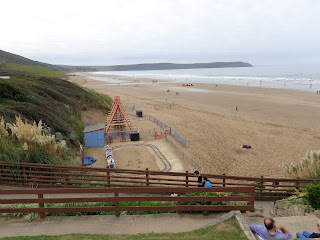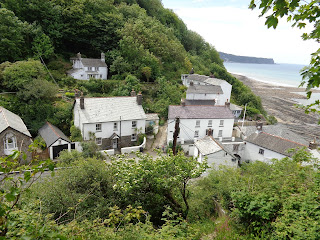Walk
174 Barnstaple/Braunton to Woolacombe (Devon)
(Third
leg of English coastal walk – Lands End to Bristol)
Map:
L/R 180
Distance: (30km/21 miles from Barnstaple) 20km or 13 miles from Braunton
Difficulty:
quite easy/moderate
Terrain:
coastal path, some sand dunes
Access:
Parking at both ends.
Public
transport: 303 bus runs between all three places but only a few go
straight through – check with Traveline website.
I
decided to get the bus to Braunton and walk from there to Woolacombe.
It is perfectly possible to walk from Barnstaple, alongside the River
Taw before cutting inland towards Braunton. Just seemed rather a long
way for not much gain as far as the coast is concerned.
The
path (also a part of the Tarka Trial) out of Braunton goes alongside
the marsh, around Horsey Island then parallel with Braunton Burrows and Saunton Sands. Be careful here as I came across several
members of the army with machine guns who politely but firmly pointed
out the way I should go! Look out for any military 'danger area'
notices as well. The sand dunes on the burrows are some of the most
protected and treasured environments in the UK with 33 species of
butterflies and 470 species of flowering plants.
It
feels like a long walk through the Burrows and on to Croyde Bay -
another place popular with surfers that has potentially dangerous
tides. Near to the path at Croyde is a notice erected by The National
Trust; it is alongside some old whale bones which are the only
remains of a whale washed up here in 1915.
The
path goes around Baggy Point which is now managed by The National
Trust. There is evidence of 7000 years of human activity in this area
including medieval farms, D Day troop manoeuvres and shipwrecks, including HMS Weazle that met its end with the loss of 105 lives. The head
is riddled with caves, and seals can be seen basking on the rocks.
Lookout for the Coastguard Training Pole (seen better days) which
dates back to 1930. The National Trust, as part of a heritage year in
2015, were seeking to replace it. Coastguards fired rescue lines tied
to the post to a ship in trouble and people would be rescued one by
one on a breeches buoy.
Coming
away from Baggy Point the path continues alongside the two miles of
surfing beaches at Woolacombe Sand and into Woolacombe. The town
expanded in the middle of the 19th century when it became
popular with tourists. The beach here was used by American troops to
train for the D Day landings. They set up their local HQ at the
Woolacombe Bay Hotel.
Photos show: Braunton Burrows and Saunton Sands; Woolacombe Sand looking to Baggy Point.













